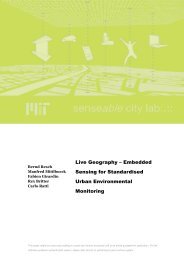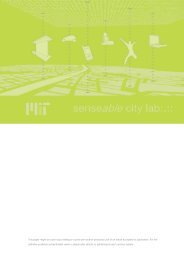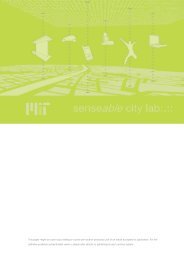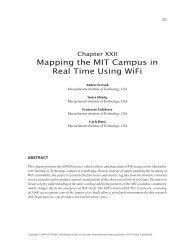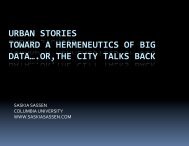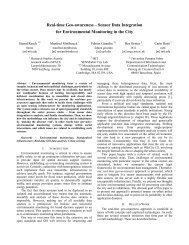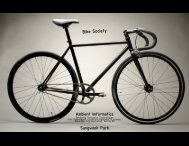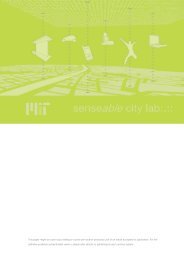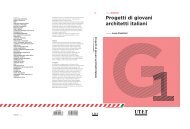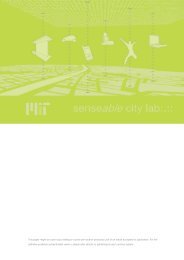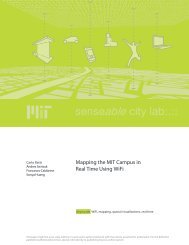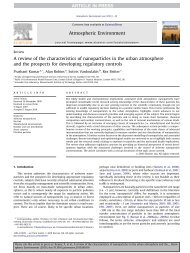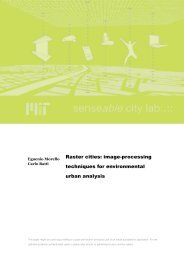Carlo Ratti - MIT SENSEable City Lab
Carlo Ratti - MIT SENSEable City Lab
Carlo Ratti - MIT SENSEable City Lab
You also want an ePaper? Increase the reach of your titles
YUMPU automatically turns print PDFs into web optimized ePapers that Google loves.
differentiated structures at the urban scale” (Lynch, 1960, p. 95). The following five visual elements show<br />
different qualities that make them easily identifiable (1960, pp. 46-83): paths, nodes, districts, edges, landmarks.<br />
In the Space Syntax study by Conroy Dalton and Bafna (2003) mentioned above, the authors acknowledge<br />
that spatial representation using isovists could potentially be useful to overcome the simplifications due to onedimensional<br />
axial lines. Isovists allow the consideration of the spatial character and the boundaries of what can be<br />
seen from vantage points, enlarging simple results based only on connectivity of lines-of-sight. In general, Space<br />
Syntax approach emphasizes structural aspects of Lynch’s theory, whereas the present technique highlights<br />
visibility aspects.<br />
For instance, all analyses on the five visual elements can be conducted on the DEMs, calculating the<br />
isovists along specific directions. To interpret Lynch’s visual elements it is necessary to better understand their<br />
meaning and try to apply specific calculations for each element.<br />
Some analyses might require, for example, calculations based on simple 2-D isovists (nodes and districts),<br />
others (edges and landmarks) require a more complex voxel space. In any case, we provide calculations on 3-D<br />
isovists, which seem to be more faithful to actual visual experience and do not imply a more time-consuming<br />
computation. In table 3 all five visual elements are characterized and for each an example based on the case study<br />
of the Milan Trade Fair and a calculation method are presented. A brief explanation for each element follows.<br />
Paths, nodes and districts<br />
Below we summarize the definitions given by Kevin Lynch:<br />
! Paths (streets, walkways, transit lines, canals, railroads) are channels along which the observer,<br />
customarily, occasionally, or potentially moves. Paths are predominant elements and people observe the<br />
environment while moving through paths. They are characterized by: continuity, directional quality,<br />
gradients (for example: gradient of use intensity, prolonged curves).<br />
! Nodes (junctions, places of break in transportation, crossing of paths) are points, strategic spots in a city<br />
into which an observer can enter, and which are the intensive foci to and from which he is travelling.<br />
Otherwise they can represent concentrations.<br />
! Districts (city regions, neighbourhoods) are the medium-to-large sections of the city, conceived of as<br />
having two-dimensional extent. Districts have common character: shape, texture, class, ethnic area.<br />
The first two geo-referred visual elements can be easily computed with simple analyses on 2-D isovists;<br />
the analysis of districts, however, requires a more complex interpretation that does not exclusively concerns the<br />
study of visual aspect, but also deals with structural aspects of the city at a larger scale. Isovistfields can highlight<br />
8



